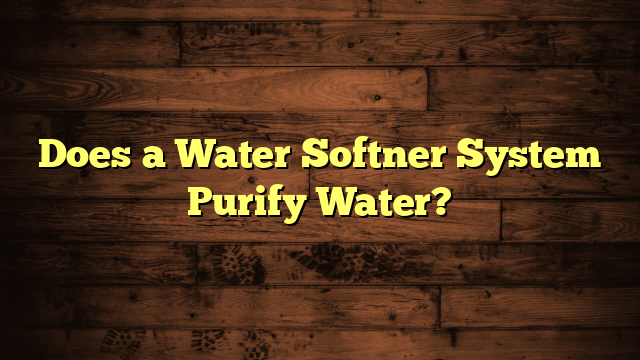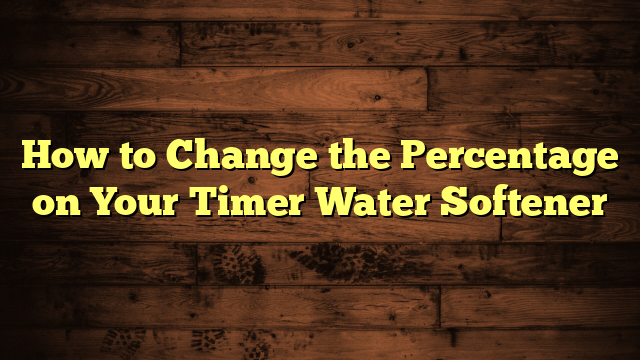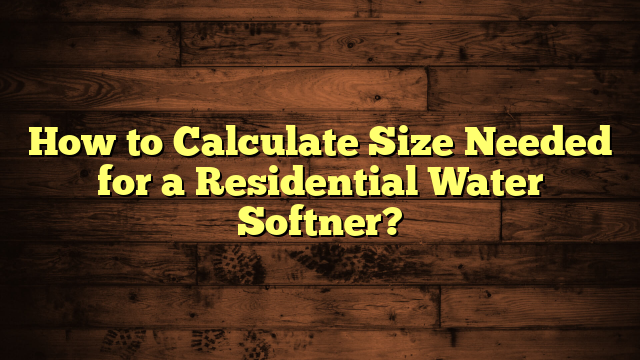Does a Water Softner System Purify Water?
When you consider water softening, water purification, and overall water quality, it's essential to understand the distinctions between these processes. You might think a water softener simplifies your water issues, but it actually focuses on reducing hardness rather than purifying it. While it improves lather and prevents scale buildup, it doesn't address harmful contaminants. So, what does this mean for your drinking water? Understanding these nuances can greatly influence your choices for safe and effective water treatment solutions.
Key Takeaways
- A water softener primarily addresses water hardness by replacing calcium and magnesium with sodium or potassium ions, not purifying water.
- Water softeners do not remove contaminants like chlorine, lead, or bacteria, limiting their role in overall water purification.
- The system enhances water quality by reducing scale buildup but does not ensure safe drinking water free of impurities.
- Additional filtration methods, like activated carbon filters or reverse osmosis, are necessary for comprehensive purification alongside water softening.
- Combining water softeners with purification systems results in cleaner, safer water, addressing both hardness and contamination issues.
Understanding Water Softening
Water softening is an essential process that addresses the challenges posed by hard water. If you've ever noticed scale buildup on your faucets or a lack of lather while washing your hair, you've experienced the effects of water hardness. Hard water contains high levels of minerals, particularly calcium and magnesium, which can lead to various issues in your home.
Fortunately, softening processes can effectively reduce these minerals, providing numerous benefits for your household.
One common method for softening water is ion exchange, where hard minerals are replaced with sodium or potassium ions. This process not only protects your plumbing and appliances from scale buildup but also improves the effectiveness of soaps and detergents.
With softened water, you'll find that your laundry is cleaner, your dishes are spot-free, and your skin feels smoother after bathing.
Understanding water hardness and the softening processes available can make a significant difference in your daily life. By investing in a water softener, you can enhance your home's water quality, leading to long-term savings and a more enjoyable living environment.
What Is Water Purification?
Water purification is the process of removing contaminants from water to make it safe for drinking and other uses.
You'll find various techniques for purification, such as filtration, distillation, and chemical treatment, each with its own benefits.
Understanding these methods can help you appreciate the importance of purified water in maintaining health and enhancing the quality of your daily life.
Definition of Water Purification
While you might think of water as a simple necessity, the process of water purification is vital for ensuring its safety and quality.
Water purification refers to the methods used to remove undesirable chemicals, biological contaminants, and suspended solids from water. This process is essential for maintaining high water quality, especially when considering various contamination sources. These sources can include agricultural runoff, industrial discharges, and even natural elements like sediment.
Purification methods aim to make water safe for drinking, cooking, and other household uses. By addressing contamination, you reduce the risk of waterborne diseases and health issues. This is particularly important in areas where water quality can fluctuate due to seasonal changes or pollution events.
Understanding water purification helps you appreciate the significance of having clean water in your daily life. Whether you rely on municipal systems or private wells, knowing what purification entails can guide you in making informed choices about your water sources.
Ultimately, the goal of water purification is to deliver safe, clean water that meets health standards, protecting both you and your family from potential hazards.
Techniques for Purification
Purification techniques play a central role in ensuring the safety and quality of the water you consume. Among the most effective methods are reverse osmosis and UV sterilization.
Reverse osmosis works by pushing water through a semi-permeable membrane, which filters out contaminants, including bacteria, heavy metals, and dissolved solids. This process leaves you with cleaner, safer water.
On the other hand, UV sterilization employs ultraviolet light to kill or inactivate harmful microorganisms. When water passes through a UV chamber, the light disrupts the DNA of pathogens, rendering them unable to reproduce and cause illness. This method is particularly effective against viruses and bacteria, making it a popular choice for households and businesses alike.
Combining these techniques can further enhance water purification. For instance, using reverse osmosis followed by UV sterilization offers a robust solution, ensuring that the water you drink isn't only free from physical impurities but also safe from biological threats.
Benefits of Purified Water
Access to purified water comes with numerous benefits that can greatly enhance your health and well-being. When you drink clean water, you're not just quenching your thirst; you're also reaping significant health benefits that contribute to your overall hydration significance.
Here are some key advantages:
- Improved Digestion: Purified water aids in digestion and helps prevent constipation.
- Enhanced Skin Health: Staying hydrated with clean water can lead to healthier, clearer skin.
- Reduced Risk of Illness: Drinking purified water minimizes exposure to harmful contaminants, lowering the risk of waterborne diseases.
Moreover, proper hydration is crucial for maintaining energy levels and cognitive function. When your body receives adequate purified water, it can operate more efficiently.
You'll feel more alert and focused, making daily tasks easier to handle.
Incorporating purified water into your daily routine isn't just a luxury; it's a crucial step toward achieving ideal health.
With all these benefits at your fingertips, ensuring access to purified water should be a priority for you and your family.
Key Differences Explained
Water softeners come in various types, each designed to tackle hard water issues differently. Understanding these differences is essential for improving your water quality and system efficiency. Here's a quick look at three main types of water softeners:
| Type | Description | System Efficiency |
|---|---|---|
| Ion Exchange | Uses resin beads to replace hard minerals with sodium. | High; effective for severe hard water issues. |
| Salt-Free | Uses a chemical process to prevent scale buildup without sodium. | Moderate; good for maintenance but less effective for existing hardness. |
| Reverse Osmosis | Filters out contaminants and minerals through a semi-permeable membrane. | Very high; purifies water but also removes beneficial minerals. |
Choosing the right system depends on your specific needs. For instance, if you're dealing with high hardness levels, an ion exchange system might be your best bet. On the other hand, if you're looking to maintain water quality without adding sodium, a salt-free system could be ideal. Each type offers unique benefits, so consider what aligns best with your household's needs and priorities.
Benefits of Water Softeners
Reducing hard water issues can greatly enhance your daily life, and water softeners offer a multitude of benefits that make them a worthwhile investment.
By addressing hard water problems, you'll not only improve your living conditions but also enjoy significant advantages.
Here are three key benefits of using a water softener:
- Cost Savings: Softened water can lead to lower energy bills. Appliances like dishwashers and water heaters run more efficiently, saving you money over time.
- Improved Appliance Longevity: Hard water can cause scale buildup, leading to frequent repairs or replacements. With softened water, your appliances will last longer, reducing maintenance requirements.
- Softer Skin and Hair: Softened water can enhance your bathing experience, leaving your skin feeling smoother and your hair softer. It can also help reduce soap usage, offering yet another layer of cost savings.
Investing in a water softener means you're taking a proactive step toward better water quality in your home.
You'll notice the difference from your appliances to your skin, making it a smart choice for anyone dealing with hard water issues.
Limitations of Water Softeners
While water softeners effectively remove hard minerals, they come with some limitations you should know about.
For instance, they don't filter out contaminants, meaning your water might still carry unwanted substances.
Furthermore, their effectiveness is limited to addressing water hardness, so they mightn't solve all your water quality issues.
Removes Hard Minerals
Removing hard minerals from your water can considerably improve its quality, but water softeners have their limitations. While they effectively provide hard mineral removal, allowing you to enjoy soft water benefits, they don't address all your water concerns.
Here are three key points to take into account about water softeners:
- Sodium Levels: Water softeners often replace hard minerals with sodium, which can be a concern for those on low-sodium diets.
- Taste Changes: Some people find that softened water has a different taste, which may not be appealing to everyone.
- Limited Scope: While they tackle calcium and magnesium, water softeners won't remove other contaminants like chlorine, lead, or bacteria.
It's crucial to understand that while enjoying the smooth feel of soft water and the benefits it brings to your appliances and skin, you might still want to explore additional filtration systems.
Balancing hard mineral removal with overall water quality guarantees that you're not just getting soft water but also clean, safe water for your household.
Does Not Filter Contaminants
Despite their effectiveness in softening water, water softeners don't filter out many harmful contaminants. So, while you might enjoy the benefits of softened water, it's vital to recognize that your water could still contain various water contaminants. These include things like chlorine, lead, pesticides, and bacteria, which softeners simply can't eliminate.
To address these contaminants, you'd need to look into additional filtration methods. Common options include activated carbon filters, reverse osmosis systems, and ultraviolet (UV) purification. Each of these methods targets specific contaminants, providing a more thorough approach to water purification.
If you're concerned about the quality of your water, combining a water softener with one of these filtration systems can be an effective solution. This way, you'll enjoy the benefits of soft water while ensuring that harmful substances are filtered out.
Ultimately, understanding the limitations of water softeners is essential for making informed choices about your home's water quality. So, even though a softener is a valuable addition, don't overlook the need for a proper filtration system to keep your water truly clean and safe.
Limited to Water Hardness
Water softeners primarily tackle the issue of water hardness, but their functionality is limited to this specific problem. While they effectively reduce the mineral content that causes hardness, they don't address other concerns affecting water quality.
Here's what you need to know:
- Mineral buildup: Water softeners can't eliminate all minerals; they primarily target calcium and magnesium. Other minerals may still contribute to buildup.
- Contaminants: These systems don't filter out harmful substances like bacteria, heavy metals, or chemicals, which can still be present in your water supply.
- Taste and odor: Softened water may still retain unpleasant tastes or odors from organic compounds or chlorine.
If you're aiming for better overall water quality, a water softener alone won't be enough. You might need additional filtration systems to remove contaminants and improve taste.
Keep in mind that while softening water can help with issues like scale buildup in pipes and appliances, it's just one piece of the puzzle. For thorough water treatment, consider combining a water softener with other purification methods tailored to your specific needs.
Alternative Water Purification Methods
When it comes to guaranteeing clean drinking water, you've got several alternative purification methods at your disposal. One popular option is reverse osmosis. This method uses a semi-permeable membrane to remove impurities from water, including heavy metals, chlorine, and other contaminants. The result is pure water that's safe to drink and great for cooking.
Another effective method is UV sterilization. This process uses ultraviolet light to kill bacteria, viruses, and other pathogens in the water. It's a chemical-free option that's especially useful if you're concerned about biological contaminants. UV sterilization doesn't alter the taste or odor of the water, maintaining its natural qualities.
Both methods have their pros and cons. Reverse osmosis systems can be more expensive and may waste some water during the filtration process, while UV sterilization requires electricity and won't remove chemical contaminants. However, they can be used together for thorough purification.
Ultimately, understanding these alternative methods can help you make informed decisions about your water quality. By exploring options like reverse osmosis and UV sterilization, you can guarantee your drinking water isn't only soft but also safe and clean.
Choosing the Right System
Reflecting on your specific needs and circumstances is essential when choosing the right water softener system. Start by evaluating your water hardness level and household size, as these factors play a significant role in system selection.
You'll want a system that efficiently meets your water usage demands while effectively softening your water.
Here are three key points to take into account during your brand comparison:
- Flow Rate: Verify the system can handle your household's peak water usage.
- Salt Efficiency: Look for models that minimize salt consumption, which can save you money in the long run.
- Maintenance Requirements: Choose a system that fits your lifestyle. Some require more upkeep than others.
Once you've narrowed down your options, don't forget to read customer reviews and compare warranties.
A reputable brand will typically offer robust customer support and quality assurance. By reflecting on these elements, you can confidently select a water softener that not only fits your needs but also enhances your overall water quality.
Final Thoughts on Water Quality
Selecting the right water softener is just the first step in guaranteeing high-quality water for your home. While water softeners effectively reduce hardness, they don't purify water. To achieve the best water quality, you need to take into account water testing and filtration systems.
Start by testing your water to identify contaminants or impurities that may be present. This will help you determine if additional filtration is necessary.
Once you have the results, you can explore various filtration systems tailored to your specific needs. These systems can remove chlorine, sediment, and other harmful substances, providing you with clean, safe drinking water.
It's important to remember that not all filtration systems are created equal, so choose one that aligns with your water quality goals.
Regular maintenance of both your water softener and filtration systems is essential. This guarantees they operate efficiently and continue providing high-quality water.
By taking these steps, you can enjoy the benefits of both softened and purified water, making your home a healthier environment for you and your family.
Ultimately, investing in water testing and filtration will give you peace of mind, knowing that your water is as pure and safe as possible.
Frequently Asked Questions
Can Water Softeners Remove Harmful Bacteria From Water?
Water softeners don't effectively remove harmful bacteria from water. They focus on reducing mineral content, not bacterial removal. For proper water purification, consider using a filtration system designed to eliminate harmful microorganisms and guarantee safe drinking water.
Do Water Softeners Affect Water Taste or Odor?
Water softeners can work wonders for your water quality, almost like magic! They often enhance taste by removing minerals that cause bitterness, leading to a smoother, more invigorating experience. You'll love the difference in flavor!
How Often Should I Maintain My Water Softener?
You should perform water softener maintenance every two to four months. Regularly check salt levels and clean the system to guarantee ideal softener performance evaluation, preventing issues and extending your unit's life.
Can a Water Softener Damage My Plumbing?
A water softener's gentle touch can actually protect your plumbing, but if not maintained, it might lead to pipe corrosion. Regular plumbing maintenance guarantees your system runs smoothly, keeping your pipes safe and sound.
Are Water Softeners Effective for Well Water?
Water softeners can be effective for well water, improving its quality by removing excess minerals like calcium and magnesium. You'll notice softer water, reduced scale buildup, and better soap efficiency, enhancing your overall water experience.
Conclusion
In summary, while a water softener system can transform hard water into a gentler version of itself, it doesn't purify water. Think of it as polishing a stone; it shines, but the impurities remain. To guarantee your water is both soft and safe, combine softening with additional filtration methods. This way, you'll enjoy the benefits of soft water while safeguarding against contaminants, creating a balanced solution for your home's water needs.







